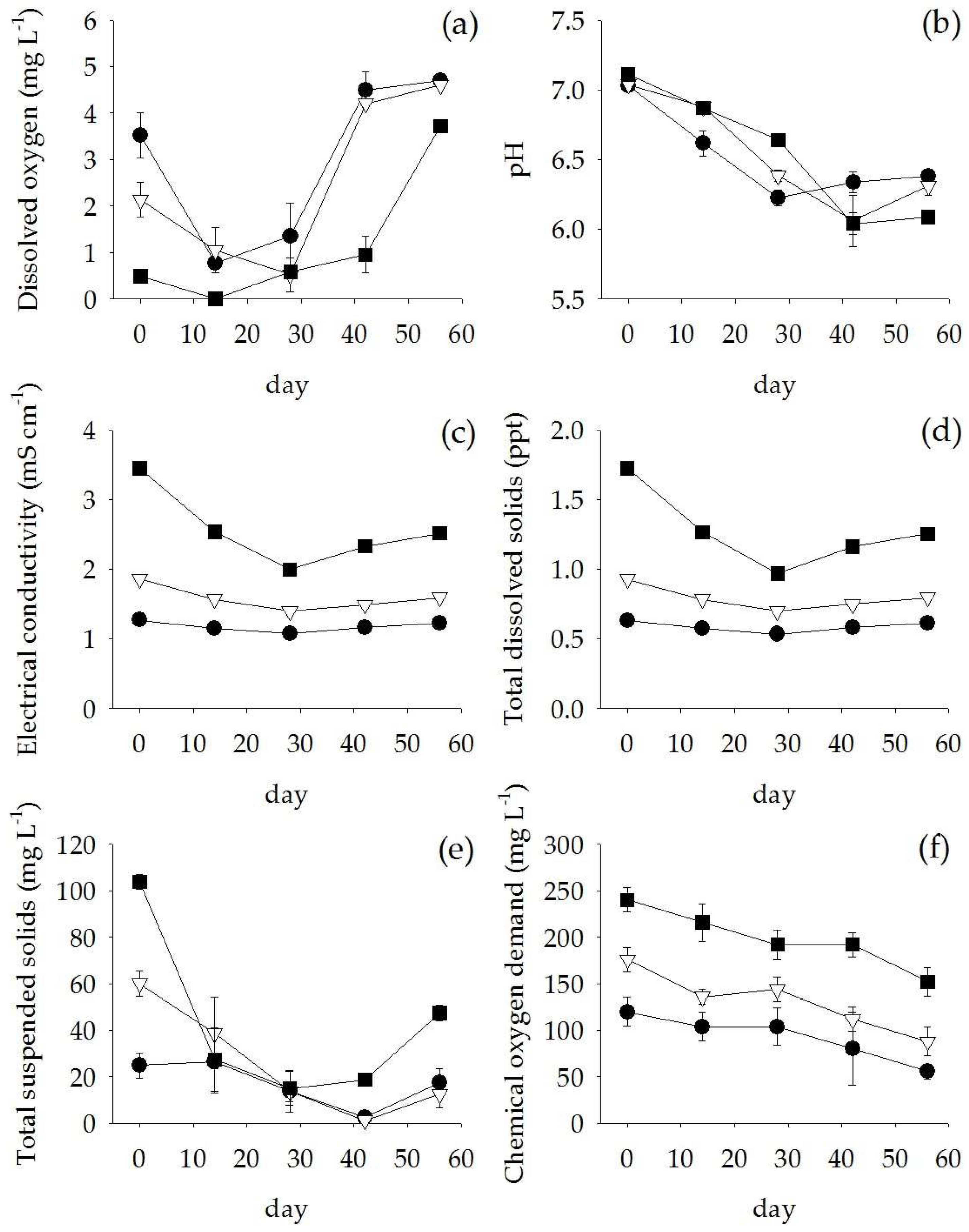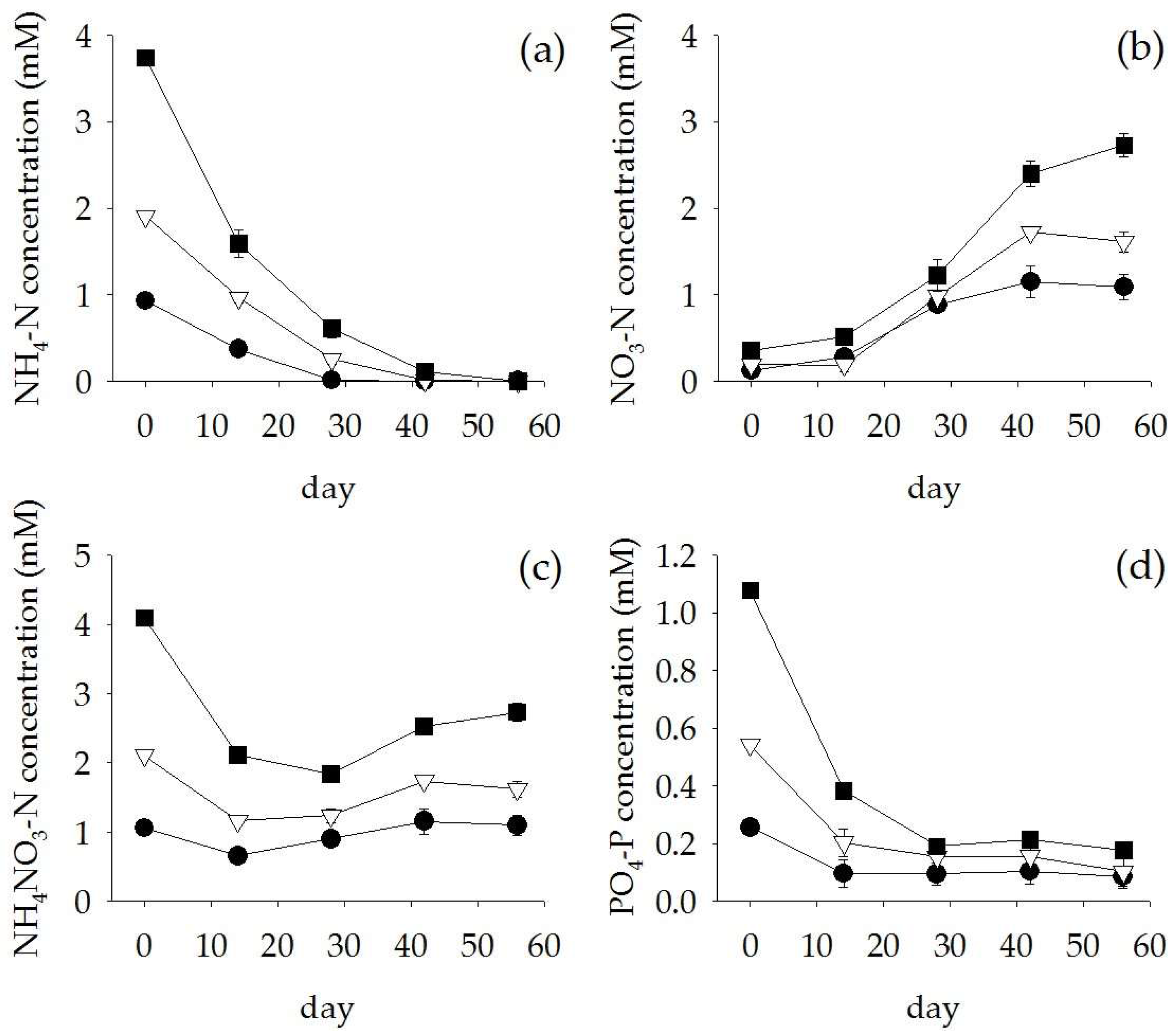Treatment of Anaerobic Digester Effluent Using Acorus calamus: Effects on Plant Growth and Tissue Composition
Abstract
:1. Introduction
2. Results
2.1. Plant Growth and Morphology
2.2. Pigment Contents
2.3. NH4+ and NO3− in the Plant Tissue
2.4. Nutrients and Minerals in the Plant Tissue
2.5. Water Quality
3. Discussion
4. Materials and Methods
4.1. Anaerobic Digester Effluent
4.2. Plant Culture and Experimental Set-Up
4.3. Plant Growth and Morphology
4.4. Pigments
4.5. Nutrients and Minerals in Plant Tissue
4.6. Water Analysis
4.7. Statistics
5. Conclusions
Acknowledgments
Author Contributions
Conflicts of Interest
References
- Hairston, J.E.; Stribling, L. Animal Waste Management to Protect Water Quality: Animal Waste and How it Affects Water Quality; Alabama Cooperative Extension System, Alabama A&M University: Huntsville, AL, USA; Auburn University: Auburn, AL, USA, 1995. [Google Scholar]
- World Health Organization. Animal Waste, Water Quality and Human Health; IWA publishing: London, UK, 2012. [Google Scholar]
- Bruinsma, J. (Ed.) World Agriculture: Towards 2015/2030—An FAO Perspective; Earthscan: London, UK, 2003. [Google Scholar]
- Chen, Y.; Cheng, J.J.; Creamer, K.S. Inhibition of anaerobic digestion process: A review. Bioresour. Technol. 2008, 99, 4044–4064. [Google Scholar] [CrossRef] [PubMed]
- Khalid, A.; Arshad, M.; Anjum, M.; Mahmood, T.; Dawson, L. The anaerobic digestion of solid organic waste. Waste Manag. 2011, 31, 1737–1744. [Google Scholar] [CrossRef] [PubMed]
- Lee, C.Y.; Lee, C.C.; Lee, F.Y.; Tseng, S.K.; Liao, C.J. Performance of subsurface flow constructed wetland taking pretreated swine effluent under heavy loads. Bioresour. Technol. 2004, 92, 173–179. [Google Scholar] [CrossRef] [PubMed]
- Deng, L.; Zheng, P.; Chen, Z.; Mahmood, Q. Improvement in post-treatment of digested swine wastewater. Bioresour. Technol. 2008, 99, 3136–3145. [Google Scholar] [CrossRef] [PubMed]
- Liu, G.J.; Zheng, D.; Deng, L.W.; Wen, Q.; Liu, Y. Comparison of constructed wetland and stabilization pond for the treatment of digested effluent of swine wastewater. Environ. Technol. 2014, 35, 2660–2669. [Google Scholar] [CrossRef] [PubMed]
- Wen, S.; Liu, H.; He, H.; Luo, L.; Li, X.; Zeng, G.; Zhou, Z.; Lou, W.; Yang, C. Treatment of anaerobically digested swine wastewater by Rhodobacter blasticus and Rhodobacter capsulatus. Bioresour. Technol. 2016, 222, 33–38. [Google Scholar] [CrossRef] [PubMed]
- Kayhanian, M. Ammonium inhibition in high-solids biogasification: An overview and practical solutions. Environ. Technol. 1999, 20, 355–365. [Google Scholar] [CrossRef]
- Sánchez, E.; Borja, R.; Weiland, P.; Travieso, L.; Martín, A. Effect of temperature and pH on the kinetics of methane production, organic nitrogen and phosphorus removal in the batch anaerobic digestion process of cattle manure. Bioprocess Eng. 2000, 22, 247–252. [Google Scholar] [CrossRef]
- Vymazal, J. Constructed wetlands for wastewater treatement. Water 2010, 2, 530–549. [Google Scholar] [CrossRef]
- Brix, H. Do macrophytes play a role in constructed treatment wetlands? Water Sci. Technol. 1997, 35, 11–17. [Google Scholar]
- Karathanasis, A.D.; Potter, C.L.; Coyne, M.S. Vegetation effects on fecal bacteria, BOD and suspended solid removal in constructed wetlands treating domestic wastewater. Ecol. Eng. 2003, 20, 157–169. [Google Scholar] [CrossRef]
- Zhao, Y.; Liu, B.; Zhang, W.; Kong, W.; Hu, C.; An, S. Comparison of the treatment performances of high-strength wastewater in vertical subsurface flow constructed wetlands planted with Acorus calamus and Lythrum salicaria. J. Health Sci. 2009, 55, 757–766. [Google Scholar] [CrossRef]
- Motley, T.J. The ethnobotany of sweet flag, Acorus calamus (Aracaceae). Econ. Bot. 1994, 48, 397–412. [Google Scholar] [CrossRef]
- Bhat, S.D.; Ashok, B.K.; Bhat, D.V.; Acharya, R.; Shukla, V.J. A comparative phytochemical evaluation of wild and cultivated Acorus calamus Linn (vacha) with special reference to β-Asarone content. Inven. Rapid Pharm Anal. Qual. Assur. 2011, 2, 1–4. [Google Scholar]
- Singh, R.; Sharma, P.K.; Malviya, R. Pharmacological properties and Ayurvedic value of Indian buch plant (Acorus calamus): A short review. Adv. Biol. Res. 2011, 5, 145–154. [Google Scholar]
- Dykyjová, D. Production ecology of Acorus calamus. Folia Geobot. Phytotxon. 1980, 15, 29–57. [Google Scholar] [CrossRef]
- Weber, M.; Brändle, R. Dynamics of nitrogen-rich compounds in roots, rhizomes and leaves of the sweet flag (Acorus calamus L.) at its natural site. Flora 1994, 189, 63–68. [Google Scholar] [CrossRef]
- Weber, M.; Brändle, R. Some aspects of the extreme anoxia tolerance of the sweet flag, Acorus calamus L. Folia Geobot. Phytotxon. 1996, 31, 37–46. [Google Scholar] [CrossRef]
- Wang, W.Q.; Sardans, J.; Wang, C.; Zeng, C.S.; Tong, C.; Asensio, D.; Penuelas, J. Ecological stoichiometry of C, N and P of invasive Phragmites australis and native Cyperus malaccensis species in the Minjiang River tidal estuarine wetlands of China. Plant Ecol. 2015, 216, 809–822. [Google Scholar] [CrossRef]
- Frost, P.C.; Hicks, A.L. Human shoreline development and the nutrient stoichiometry of aquatic plant communities in Canadian Shield lakes. Can. J. Fish. Aquat. Sci. 2012, 69, 1642–1650. [Google Scholar] [CrossRef]
- Votjíšková, L.; Munzarová, E.; Votrubová, O.; Řihová, A.; Juřicová, B. Growth and biomass allocation of sweet flag (Acorus calamus L.) under different nutrient conditions. Hydrobiologia 2004, 518, 9–22. [Google Scholar]
- Tanner, C.C. Plants for constructed wetland treatment systems—A comparison of the growth and nutrient uptake of eight emergent species. Ecol. Eng. 1996, 7, 59–83. [Google Scholar] [CrossRef]
- Calheiros, C.S.C.; Quitério, P.V.B.; Silva, G.; Crispim, L.F.C.; Brix, H.; Moura, S.C.; Castro, P.M.L. Use of constructed wetland systems with Arundo and Sarcocornia for polishing high salinity tannery wastewater. J. Environ. Manag. 2012, 95, 66–71. [Google Scholar] [CrossRef] [PubMed]
- Vincent, G.; Shang, K.; Zhang, G.; Chazarenc, F.; Brisson, J. Plant growth and nutrient uptake in treatment wetlands for water with low pollutant concentration. Water Sci. Technol. 2017. [Google Scholar] [CrossRef] [PubMed]
- Poach, M.E.; Hunt, P.G.; Reddy, G.B.; Stone, K.C.; Johnson, M.H.; Grubbs, A. Effect of intermittent drainage on swine wastewater treatment by marsh–pond–marsh constructed wetlands. Ecol. Eng. 2007, 30, 43–50. [Google Scholar] [CrossRef]
- González, F.T.; Vallejos, G.G.; Silveira, J.H.; Franco, C.Q.; García, J.; Puigagut, J. Treatment of swine wastewater with subsurface-flow constructed wetlands in Yucatán, Mexico: Influence of plant species and contact time. Water SA 2009, 35, 335–342. [Google Scholar] [CrossRef]
- Borin, M.; Politeo, M.; Stefani, G.D. Performance of a hybrid constructed wetland treating piggery wastewater. Ecol. Eng. 2013, 51, 229–236. [Google Scholar] [CrossRef]
- Fu, X. Phosphorus removal from wastewater by five aquatic plants. In Proceedings of the 3rd International Conference on Advances in Energy and Environmental Science 2015, Zhuhai, China, 25–26 July 2015; Yarlagadda, P., Ed.; Atlantis Press: Paris, France, 2015; pp. 1013–1017. [Google Scholar]
- Klomjek, P. Swine wastewater treatment using vertical subsurface flow constructed wetland planted with Napier grass. Sustain. Environ. Res. 2016, 26, 217–223. [Google Scholar] [CrossRef]
- Smart, R.M.; Barko, J.W. Laboratory culture of submersed freshwater macrophytes on natural sediments. Aquat. Bot. 1985, 21, 251–263. [Google Scholar] [CrossRef]
- Lichtenthaler, H.K. Cholophylls and carotenoids: Pigments of photosynthetic biomembranes. Methods Enzymol. 1987, 148, 350–382. [Google Scholar]
- Cedergreen, N.; Madsen, T.V. Nitrogen uptake by the floating macrophyte Lemna minor. New Phytol. 2002, 155, 285–292. [Google Scholar] [CrossRef]
- American Public Health Association; American Water Works Association; Water Environment Federation. Standard Methods for the Examination of Water and Wastewater, 20th ed.; American Public Health Association: Washington, DC, USA, 1998. [Google Scholar]
- SPSS. SPSS for Windows, Standard Version 17.0; SPSS Inc.: Chicago, IL, USA, 2007. [Google Scholar]





 ) and 50% (
) and 50% (  ) diluted anaerobic digester effluent and 100% anaerobic digester effluent (
) diluted anaerobic digester effluent and 100% anaerobic digester effluent (  ) during 56 days of experiment.
) during 56 days of experiment.
 ) and 50% (
) and 50% (  ) diluted anaerobic digester effluent and 100% anaerobic digester effluent (
) diluted anaerobic digester effluent and 100% anaerobic digester effluent (  ) during 56 days of experiment.
) during 56 days of experiment.
 ) and 50% (
) and 50% (  ) diluted anaerobic digester effluent and 100% anaerobic digester effluent (
) diluted anaerobic digester effluent and 100% anaerobic digester effluent (  ) during 56 days of experiment.
) during 56 days of experiment.
 ) and 50% (
) and 50% (  ) diluted anaerobic digester effluent and 100% anaerobic digester effluent (
) diluted anaerobic digester effluent and 100% anaerobic digester effluent (  ) during 56 days of experiment.
) during 56 days of experiment.

| Parameters | Mean values |
|---|---|
| Water temperature (°C) | 29.1 |
| pH | 7.1 |
| Electrical conductivity (mS cm−1) | 3.4 |
| Dissolved oxygen (mg L−1) | 0.5 |
| Total dissolved solids (ppt) | 1.7 |
| Total suspended solids (mg L−1) | 103.8 |
| Chemical oxygen demand (mg L−1) | 192.0 |
| NH4-N concentration (mM) | 3.7 |
| NO3-N concentration (mM) | 0.4 |
| Orthophosphate (PO4-P) concentration (mM) | 1.1 |
© 2018 by the authors. Licensee MDPI, Basel, Switzerland. This article is an open access article distributed under the terms and conditions of the Creative Commons Attribution (CC BY) license (http://creativecommons.org/licenses/by/4.0/).
Share and Cite
Pincam, T.; Brix, H.; Jampeetong, A. Treatment of Anaerobic Digester Effluent Using Acorus calamus: Effects on Plant Growth and Tissue Composition. Plants 2018, 7, 36. https://doi.org/10.3390/plants7020036
Pincam T, Brix H, Jampeetong A. Treatment of Anaerobic Digester Effluent Using Acorus calamus: Effects on Plant Growth and Tissue Composition. Plants. 2018; 7(2):36. https://doi.org/10.3390/plants7020036
Chicago/Turabian StylePincam, Tararag, Hans Brix, and Arunothai Jampeetong. 2018. "Treatment of Anaerobic Digester Effluent Using Acorus calamus: Effects on Plant Growth and Tissue Composition" Plants 7, no. 2: 36. https://doi.org/10.3390/plants7020036






